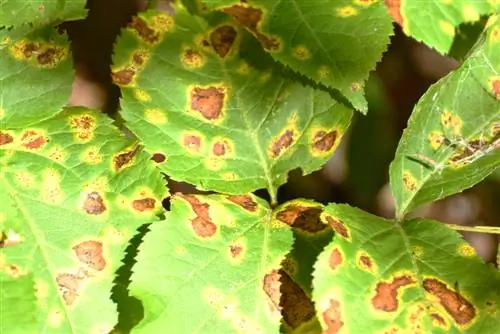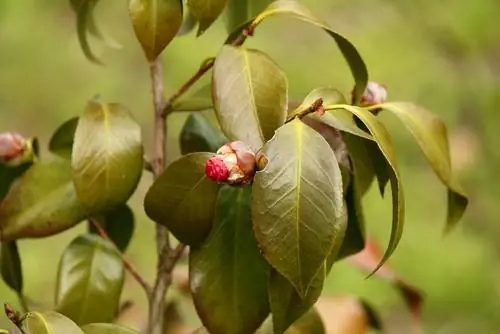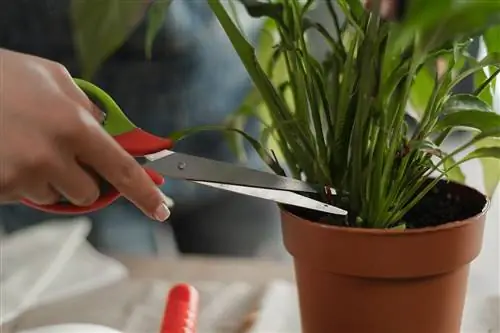- Author admin [email protected].
- Public 2023-12-16 16:46.
- Last modified 2025-01-23 11:22.
Leaf spot disease is common on both garden and houseplants. Various pathogens are responsible for the differently shaped and colored leaf spots, which are often difficult to combat.
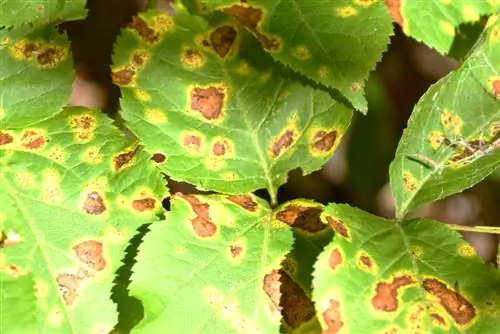
What is leaf spot and how can you combat it?
Leaf spot can be caused by fungi, bacteria or viruses and occurs on garden and house plants. Heavy pruning of the affected parts of the plant usually helps to combat it, while preventative measures such as species-appropriate location, correct planting distance and he althy mixed and subsequent crops can prevent infections.
- Leaf spot disease is usually caused by harmful fungi.
- However, sometimes bacteria or viruses can also be responsible for the infection.
- There are no effective home remedies, usually only a strong pruning helps.
- Careful planting and care is important to prevent the disease.
Harmful symptoms and pathogens
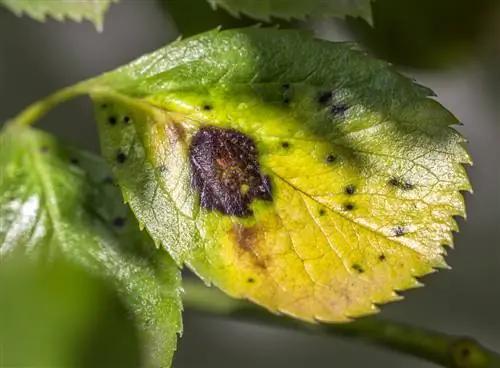
Fungus, bacteria or viruses can be responsible for leaf spot disease
First of all: “The” leaf spot disease does not exist because the characteristic symptoms are caused by many different pathogens. Fungi are often behind the infection, but bacteria or viruses can also be the cause. The type of pathogen determines the form of treatment, which is why you should look closely at the symptoms and differentiate between them. While fungal leaf spot diseases can usually be managed quite easily, bacterial or viral forms are difficult to control.
Tip
The weather at the time of occurrence provides an initial indication of the possible pathogen, as some forms prefer to occur in cool and humid, warm and humid or warm and dry weather. Often just a short rain shower (after the leaves don't dry quickly enough) or morning dew is enough for an infection.
Fungal pathogens
The possible fungal causes of leaf spot come from three different fungal genera. You can find out what these are and how you can distinguish them based on their characteristic symptoms in the following table.
| Alternaria (molds / black fungi) | Ascochyta (ascomycetes) | Septoria (other types of ascomycetes) | |
|---|---|---|---|
| Characteristics | occur particularly in dry and warm weather with little rainfall | occur mainly in cool and damp weather | Infestation occurs primarily at temperatures between 20 and 25 °C |
| Infection / transmission route | Spores overwinter in the soil or in plant residues and are transmitted by wind | Plant seedlings are already being attacked | Transmission often through infected seeds |
| malicious image | initially tiny, sharply defined dark brown to black dots, gradually becoming larger and running into each other | Elongated, brown leaf spots with a grayish center, often covered with small dark spots | initially yellowish leaf spots that run into each other, from which spherical fungal spores grow |
| Illness progression | As it progresses, tubers and fruits are also affected | Stems also affected with sunken spots, growth disorders | Leaf wilt and fall |
Typical for all bacterial forms of leaf spot is the formation of fungal turf in the affected areas as well as spore deposits, which are often located on the underside of the leaves.
Tip
The shotgun disease, which mainly occurs on stone fruits such as plums and cherries, is also a leaf spot disease caused by fungi. It is caused by the fungus Wilsonomyces carpophilus and occurs primarily as a result of a wet spring.
Bacterial and viral pathogens
More rarely, bacteria or viruses cause various forms of leaf spot diseases.
- Viral pathogens: You can recognize a viral infection by the mosaic spread of the leaf spots. There are currently no effective antidotes; only vigorous pruning can save the affected plant.
- Bacterial pathogens: Often caused by bacteria of the species Pseudomonas or Xanthomonas, which spread primarily when it is wet (e.g. due to incorrect watering over the leaves or in the rain). Use injuries (e.g. caused by a plant cutting) as a gateway. No effective antidotes known.
Excursus
Not all leaf spots are caused by pathogens
Leaf spots can, however, also be caused by certain animal pests (e.g. the sucking behavior of aphids, etc.) or by physical orchemical causes such as strong sunlight (sunburn), hailstorms or harsh spray agents.
Fighting leaf spot disease
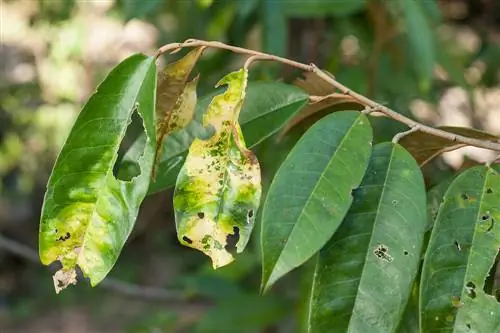
The affected leaves should be removed immediately
Since there are no effective home remedies against the various forms of leaf spot diseases, in the event of an outbreak, the only thing that helps in all variants is secateurs.
- Cut off all affected plant parts generously.
- Use freshly sharpened and disinfected cutting tools.
- Disinfect them carefully after use to avoid transferring the pathogens to he althy plants.
- Do not under any circumstances dispose of the infected clippings in the compost or even leave them as mulch.
- Instead, throw it in the trash or (if allowed) burn it.
Fungal infections can often only be treated with a broad-spectrum fungicide, as in many cases not just one, but different types of fungi have established themselves. Severely affected plants - regardless of the pathogen - sometimes just need to be removed and replaced with he althy plants.
Effective prevention
Since combating leaf spot diseases is often so difficult, effective prevention to prevent infection is particularly important. These measures will help you:
- Make sure you have a species-appropriate location with appropriate lighting and soil conditions.
- Be sure to adhere to the recommended planting distance.
- Pay attention to the rules for he althy mixed and subsequent crops, as not all plants get along with each other.
- Never pour from above, always directly onto the ground.
- Fertilize moderately and have the soil tested regularly.
- Prefer organic fertilizers.
- Strengthen your plants with homemade plant manure made from nettle or field horsetail.
“You can also prevent infections by using plants that are resistant to leaf spot diseases (certain cucumber varieties, ADR roses, etc.) or by disinfecting the seeds using garlic or field horsetail broth.”
Frequently asked questions
Which plants are particularly often affected by leaf spot diseases?
Basically, almost all garden and house plants can be affected by leaf spot diseases. However, ornamental plants such as peonies, chrysanthemums, hydrangeas, phlox, cherry laurel, rhododendrons and ivy, useful plants such as various fruit trees, cucumbers, zucchini, pumpkin and tomatoes or houseplants such as the popular flamingo flower (anthurium) are particularly at risk.
My fruit trees are affected by leaf spot disease. Can I still eat the fruit safely?
Since leaf spot diseases usually only affect the leaves, the fruits are unlikely to be diseased - provided the tree or wood is not too badly affected and the fruit can grow and ripen. Therefore, you can eat apples, pears, etc. from diseased trees without hesitation.
Tip
Leaf spot diseases occur throughout the entire growing period between April and September, whereby the spores overwinter on the diseased plant, especially when caused by fungi, and can become diseased again in warmer temperatures the following year.

